Please use the following link to download the December 21, 2024 issue of the syəcəb
Tulalip events manager takes on new role as Director of the Legacy of Healing, Children’s Advocacy Center
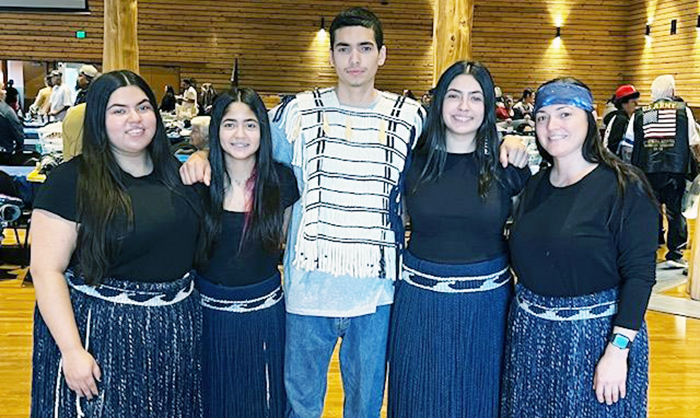
A new journey for Malory Simpson
By Kalvin Valdillez, Tulalip News
It’s not an implausible statement to say the name Malory Simpson is synonymous with the Tulalip community. Because in more ways than one, Malory is the community. Take a moment and reflect on all the Tribal events held throughout each year and pick your favorite. Chances are high that she was behind the scenes as showrunner, whether the event was cultural, celebratory, or solemn. Actually, scratch that because if we’re being honest, she was more than likely participating during that event as well. Engaging with her community while simultaneously making sure everything went without a hitch.
There are exceptions to this, however, such as school events or gatherings organized by Tribal families. But say you chose a community-driven event like the Easter Bunny Run or the annual Trunk or Treat event, guess what? Malory did that too.

As the Tribe’s events manager for the past several years, and founder of the local non-profit organization Together We’re Better, Malory has dedicated her life to the community. And along the way, she rediscovered her love for the Tulalip culture, became a prominent voice in the community, and made invaluable connections throughout the reservation. And as if she wasn’t busy enough, she also etched out some time to earn her bachelor’s degree in Human Services from the Northwest Indian College – no biggie.
All the long hours put in, experience gained, and knowledge acquired served as preparation for Malory’s new journey, which officially began the moment she accepted the position as Director of both the Legacy of Healing and the Children’s Advocacy Center. Where of course, she will continue to make a positive impact for our community in a very meaningful way.
Just two weeks in with her title still fresh, Malory agreed to an interview with Tulalip News. In this Q&A, you will learn about who Malory Simpson is, what fuels her passion for community work, her reasons on why she accepted this new role, and her desire to help and support her fellow tribal members.
Why don’t we start with a little bit about your background?
My Indian name is γʷιψαταλ. That comes from my maternal grandpa’s side. It was my great-great-great-great grandma’s Indian name and then my mom took that name on. And when she passed away, and we had her memorial, it was placed on me. It is an ancestral name, which is really cool.
My English name is Malory Simpson. On my mother’s side of the family, I come from the Gobin, Taylor side. And on my father’s side of the family is the Jones, Simpson side. My parents are Rodney and Kimberly Simpson junior, my grandparents are Betty and George Taylor, and Dawn and Glenn Simpson.
I am a mother of four. I’ve lived on the reservation my whole life; my kids have been raised out here their whole lives. That’s been kind of fun for us, living by the bay. And being able to drive by the bay every day is just healing in itself.
Let’s speak about your new role. What is your official position?
I am the Director of the Children’s Advocacy Center and the Legacy of Healing. I’m looking forward to learning all aspects of the position. I’m very much a team player, so I would love to be cross trained in all areas so I can help where it’s needed.
What drew your interest to this position?
I noticed it had been open for a while. I thought they might be having a hard time finding somebody to fit the position. And so, I reached out and asked what the duties are and what’s the schedule look like. In my previous position, I was pulled away from my family on so many evenings and holidays, and you could tell that it was putting a strain on my kids, who were wanting their mom to be home with them.
And also, just with my personal experience with domestic violence, because I am a DV survivor. And I understand with the Children’s Advocacy side, the dynamics are different. But really it was just my own personal experience with helping people in the community, the way that I have in the past, just by sharing my story. It was a big motivator for me to do it in a more professional setting. I did go to school to get a Human Services degree, and it felt like a good opportunity to actually work in the field I went to school for.
Can we dig a little deeper into the work you’ve done in the community with Together We’re Better and as the Tribe’s Events Manager?
Prior to becoming the Events Manager, I helped to coordinate community potlucks that we would host every month. And that kind of slowed down because it got really expensive for my cousin and I, who were heading it. Especially after COVID, it really slowed to just the Easter Bunny Run and our Trunk or Treat event. Those are the two huge things we do now, but eventually I think we both want to see the potlucks come back. The purpose behind that was to get our community members together. To bring all the cousins together, who didn’t really know they’re related, and provide a space for them to connect, was really neat to see.
And then I become the Events Manager. After hosting Together We’re Better events, I was able to do something similar for a profession – put on events by the Tribe that also brought our community together and provided a safe place. And in my eyes, that’s a form of prevention and healing, because some people might be struggling. By providing a meal and planning activities, people can start building relationships in the community.
As the Events Manager, you had a big hand in the first Domestic Violence Awareness Month Coastal Jam. Can you talk about that ? And did that serve as inspiration to take on the role of director at the Legacy of Healing?
I got to be on the planning team. Being able to do the footwork in the community and having established those relationships, and the network that I built in the process of it all, I was able to provide those connections to the Legacy of Healing. As the events team, we were also able to pitch in on some budgetary needs. So, we were able to purchase the t-shirts for the event, and everybody loves to get a t-shirt.
I actually got to speak at the event that year, and sometimes it can be really hard to share your story – like how do I want to say this and stay on topic and on subject? But it really is inspiring for other people. There were people who approached me and said they never knew that about me. And my story inspired our Chairwoman to get up and speak too. I will continue to share because of the inspiration it gives other people.
You are the first Tribal member to hold this position since Jade Carela took over as the Executive Director of Family Services. Why is it important to have that Tulalip representation?
It is important for Tribal members to take on roles in leadership positions. And it means a lot to our people – to have people in positions who they know and who they can trust. I feel like when they’re more comfortable, they’re more willing to open up, and they’ll want to come forward and share.
Not only have you been active in the community with TWB and the Events department, but you also have strong cultural ties. Can you talk some more about your background and love for the culture?
I would say it was probably around the time when my mom passed away in 2013 when I became more culturally involved, because I know that’s what she wanted. And before that, we really only practiced smokehouse because my mom was a smokehouse dancer. So, I was looking for other ways to expose my kids to the culture. In 2013, we started attending culture nights. And we all just kind of grew a love for that environment, as far as singing, and my kids liked learning how to dance.
It wasn’t until 2019 that we got back into practicing our culture, when my daughter Shylah decided to go on Canoe Journey. We kind of weren’t getting along at the time, so I was like okay, well you got to figure it out. And she did. She ended up going with her friend and the friend’s sister, who I trust. And when they all went, we got to go and show our support for them.
Shortly after, I took the position as Events Manager and part of that is coordinating Salmon Ceremony practice. I got to learn all this history about the songs, why we sing those songs, the order in which we sing them, and learn all the dances as well. Through learning all those things, I grew such a strong love for the culture. I remember asking, where has this been my whole life?
I feel like our culture really centers us. Our culture will always be our home and who we are. And just this last year, I joined the smokehouse myself and have been on that journey.
We really did find a love, joy, and a connection with each other through the culture, being able to sing and dance together.
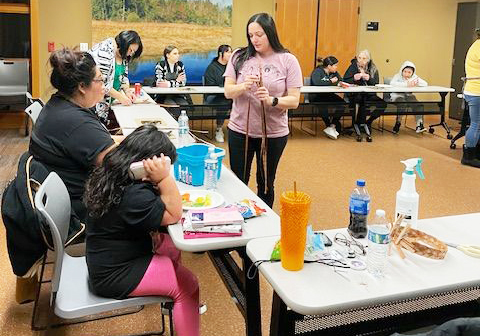
It sounds like your mom was the driving force and a big inspiration behind all the good work you’ve done for the community. Do you feel like she would be proud to see how much you’ve grown and that you’re in this position now?
I do. It’s so crazy, but I will probably always crave that. Just to hear her tell me she’s proud of me. I’m going to get emotional, but she has told me from the other side that she’s proud of me, and so I know that she is. And I know my grandparents are too. They were also a big motivator for me. There were so many things my mom wanted to do when she was here, but she didn’t have the confidence to do so. When she left, I knew I had to that for her.
A lot of the things that I do, that are community based, I do for the love of my mom. Because it was something that she was told she needed to do, but she didn’t know how to do it. That was the motivator for Together We’re Better. And she’s just a motivator for me and my kids, and I know my sisters and their kids – for all of us to continue to be good people, because she was so amazing, so loving, so open and non-judgmental. And I’m not just saying these things because she’s my mom, but because that’s totally who she was.
And she knew that you were a survivor of DV, so coming into this position, that’s a big step for you. That’s got to be something she’s happy to see.
Yes, definitely. She was also a victim of domestic violence and unfortunately it was by my dad. But they always found their way back to each other. And so, whenever I was trying to leave my relationship, she didn’t understand. But with that generation, they always tried to work it out. And I think with every generation that we have coming up after us, and all the education that is available, it changes the way we look at domestic violence and sexual assault.
Not only are we growing stronger as a people, but we are giving our children a more solid foundation so they’re even stronger than us. I always say that our kids are going to be the changemakers, and with our generation behind them, it allows them to have that voice, knowing we’ll stand by them.
Kind of like how the generation before us and the boarding school era, how scared they were to say anything and how hush hush everything had to be. It seems like with each new generation that comes, we’re going to keep getting stronger and stronger.
Now that you’re Director of the CAC and the LOH, what are you most looking forward to?
Moving forward with our team to continue to provide our community with the knowledge that they need. Also, to help maintain safety in our community by providing them with the tools through community outreach and educational outreach. One goal of mine is to bring in more culturally relevant activities and events, maybe some crafts.
And also, more education. Really getting out there and bringing that knowledge to our community. Because if you’ve been exposed to something your whole life, you don’t really know that there’s a problem. But once they get that education on it, it might raise some red flags and help open their eyes to their situation and to the realization that it may not be the healthiest relationship.
Are there any specific areas that you are particularly excited to learn more about and get into?
I’m looking forward to learning more about motivational interviewing; to learning more about all of it, especially on the advocacy side. I like to think of myself as having a strong-willed personality, so I think I’d be good at that, advocating for our clients on both sides. As a DV survivor, I understand that side. But the crimes against children, that will be tough and is new to me. So just learning skills on how to manage those situations and being there for our kids and the DV survivors.
Why is it important to have these two programs on the reservation?
Because we need programs to protect and support our kids. I feel it’s important to have a space where kids feel safe. Our advocates really take the time to walk our clients through the process and get them the services they need. And that goes for both programs. There are so many supports our Legacy of Healing provides, so many services to help DV survivors get out of those domestic violence relationships and get them on their feet after fleeing a dangerous relationship.
It can be difficult for people to come forward. Do you have any words of reassurance or advice for those individuals?
The only advice that I would say would be to really listen to that gut feeling. It’s really hard because you will have people that will ask you, why don’t you just leave? And there will come a time when you feel like that is what you need to do. Once you have that feeling, then you should act on it. And whenever you’re ready, we’re always here to help.
I think that it’s important for the community to have a strong Tribal member with auntie vibes in this position. Is that the environment you strive to create, in order for the people to feel comfortable coming to you during their hour of need?
I definitely do. In every position that I’ve held within the Tribe, I’ve tried to build and maintain relationships. My word is all I have and so if I’m telling you that I’m going to do something, I am going to follow through. Because who are we without our word? I always want people to feel comfortable talking to me about anything. I think that’s a really good quality to have.
And it’s actually funny, I just got my photo and information put up at the center this week. We had somebody here for services, and one of their little guys saw my picture and was like, ‘I think that’s my auntie’. I don’t know who he was, but I thought that was so cute. Because in my photo, I have on my beaded baseball cap and my beaded earrings, so he thought, that must be my auntie. That was so awesome.
For more information on both the Children’s Advocacy Center and the Legacy of healing, Malory submitted a short informational article in this week’s issue of the syəcəb. If you would like to get in contact with the CAC, their number is (360) 716-5437. And to reach the LOH, please contact (360) 716-4100.
————————————————
More on the CAC and the LOH
Submitted by Malory Simpson
Children’s Advocacy Center
The first Children’s Advocacy Center (CAC) opened in Huntsville, Alabama in 1985 when a local prosecutor, Bud Cramer, decided that there had to be a better way to respond to children who had made a disclosure of sexual abuse. The system was fragmented, children and families were not receiving the support they needed, and children were potentially retraumatized by a process that was supposed to be helping them. He brought together key individuals from law enforcement, child protective services, criminal justice, medical, and mental health to develop a better approach. The CAC model uses a multidisciplinary team response, pulling the different disciplines involved with investigation, prosecution, advocacy and treatment together to provide seamless, comprehensive services to child victims. As word spread about the success of the model, the Huntsville team started training other communities and the model spread.
The Children’s Advocacy
Center provides: Mental health services, advocacy, professional forensic interviewing, multi-disciplinary team services, outreach, and education.
Why a Children’s Advocacy Center? Children are among the most vulnerable members of our community. When a child is abused, we are here to provide safety, justice, and healing.
Whom do we serve? The Tulalip Children’s Advocacy Center serves children (and their non-offending family) who are victims of, or witnesses to a crime such as sexual abuse, physical abuse, or severe neglect.
What do we do? Our goal is to streamline the investigative and prosecution process of child abuse cases in a victim-centered, trauma-informed way. We do this by collaborating with those who may be involved in the case such as policing agencies, forensic medical examiners, child welfare, and those involved in the legal system.
Legacy of Healing
The Legacy of Healing provides emotional support, advocacy, and legal assistance to adult victims and survivors of all crimes, including but not limited to:
- Domestic Violence
- Sexual Assault
- Stalking
- Trafficking
- Survivors of Homicide Victims
- Arson
- Burglary
- Hate Crimes
- Identity Theft
- Elder Abuse
We also help provide Emergency Financial Assistance: Emergency financial assistance is grant-dependent and may be available to clients on a case-by-case basis. All services, including financial assistance, are based on eligibility and current funding availability.
Assistance may include:
- Basic needs assistance (food, clothing, hygiene, transportation)
- Emergency hotel stays
- Rental and move-in assistance
- Contact Information:
Children’s Advocacy Center
- 2321 Marine Drive NE
- Tulalip, WA 98271
- 360-716-5437
- childadvocates@tulaliptribes-nsn.gov
Legacy of Healing
- 7720 Waterworks Road
- Tulalip, WA 98271
- 360-716-4100
- loh@tulaliptribes-nsn.gov
Illuminating the Holidays

By Micheal Rios, Tulalip News
Embracing the spirit of the holiday season, Youth Services shuttled several dozen excited kids to Seattle for the unveiling of WildLanterns – a brand new experience at Woodland Park Zoo that is illuminated by large-scale animal and nature scape lanterns.

“We were particularly excited for this event because we know the holidays can be a financial strain for families, and by providing dinner, transportation, and zoo tickets we were doing what we could to create a memorable holiday experience,” explained Sarah Murphy, Youth Enrichment Manager. “In the days leading up to this trip, you could hear kids in the Youth Services building talking about it and asking their friends and cousins if they were going to go. Now that we’re here, you can definitely see the excitement on their faces. And for me, that’s the best part is witnessing their excitement and knowing they can have fun on and off the reservation.”
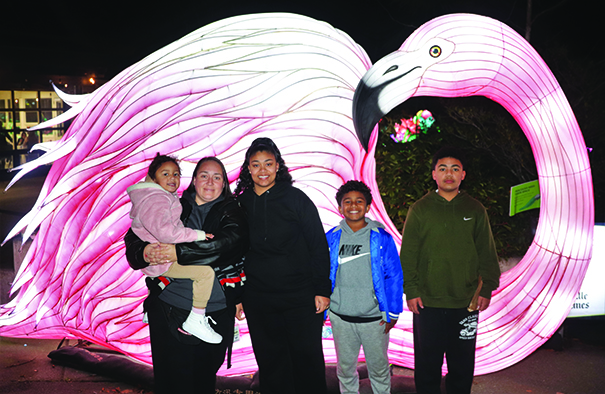
The youth, along with their chaperones, traversed through the zoo’s Mystical Forest where stunning creatures gleamed brightly. They then embarked on a journey through the bright Desert Highway to see desert flora and fauna. Imagination took flight in the Birds of Paradise Zone, where magnificent peacocks flaunted their flamboyant plumes and birds of a feather perched above on enchanted branches.
Izzy Wolftail enjoyed everything WildLanterns had to offer while being both an event chaperone and proud father to his children in attendance. “The kids are just loving all the lights and attractions, especially the interactive jump pads,” shared Izzy what walking along the Mystical Forest with the kids. “I have a 7 and 9-year-old here, too, and they keep saying they want to see everything, and we better not be missing any cool displays.
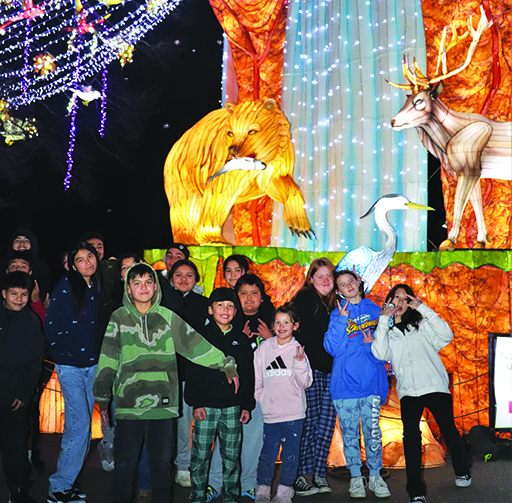
“As a tribal member and a father, I’m so grateful the Tribe gives my kids and, really, all our kids opportunities like this,” he continued. “Shoot, I’m enjoying being here and soaking in all the excitement, too. This experience is making good memories for my family to look back on one day.”
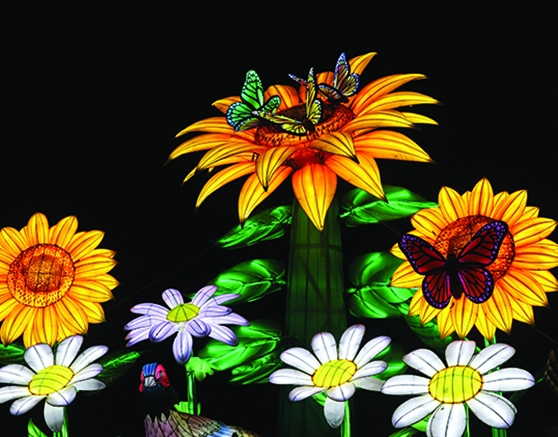
During Izzy’s interview, his 7-year-old daughter Marilyn gleefully exclaimed, “It’s so much fun! Have you seen the monkeys? If not, you better check them out!”

If you have yet to experience Woodland Park’s WildLanterns, there is still plenty of time. The illuminated zoo attraction is running from 4:00pm to 9:00pm now through January 19, 2025. Tickets can be purchased online at www.zoo.org/wildlanterns
At the behest of young Marilyn Wolftail, be sure to check out them monkeys.
Decolonizing education means growing our own teachers

Submitted by Dr. Stephanie A Fryberg
You may have seen a couple of resolutions about the Tulalip Academy of Excellence in the last board meeting. First, we’re excited to announce that we hired a consultant who specializes in fundraising. Building and operating a school is expensive. Our consultant has experience fundraising for both big building projects and for the ongoing operations of our schools. She will also help us set up a data tracking and grant management system to ensure we can continue to bring in funding in the future.
There was also an update to the Higher Education Policy adding the University of Te Whare Ranga Wananga o Awanularangi for a bachelor’s degree and teaching certification in education. If we strive for a school that amplifies student success and enhances child wellbeing, we have to completely re-write the playbook for education and that’s why we’re partnering with an internationally certified Māori Indigenous teacher certification program.
Western Education has not served our people (or any other group of people) well and revising the existing system has not worked. We need our teachers to be innovative and to have teaching and behavior management strategies that work for our children; we need to do things completely different.
Tulalip has partnered with a renowned Indigenous teacher training program in New Zealand to grow our own teachers. The program provides extensive knowledge about how children learn, what aspects make a great teacher, child developmental stages, planning, assessing and preparing for fun, engaging and challenging lessons. Future teachers are also steeped in knowledge about styles of learning and how being culturally responsive helps to enhance student engagement.
Kamiakin Craig one of the program’s first students said, “This program means that I can further provide more in my current job position and I can also serve my community in a broader way. Auntie Linda’s (Dr. Linda Tuhiwai Smith, distinguished professor at Te Whare Wānanga o Awanuiārangi) teachings stick with me in my day-to-day job and I recognize things that need to change for our people. This class has changed the way I interact with adults and children at school, I am forever changed as I am aware of not perpetuating colonial structures. Through this class I have been encouraged to continue to be who I am outside of school, to be a good relative to my students.”
By the end of the program, our tribal members will understand the art and science of teaching. This holistic—traditional learning approach to teaching—will help us be successful in the future and will ensure that our children have every educational opportunity available to them in the future.

University President
Tribal member, Julliana Jones, another one of our students, said, “I have learned more from this short time in class than I have in my entire educational experience. We’ve learned so many things in this class that I would never have learned going to any other school. One of the things I’ve learned that has shifted my thinking while taking this class has been simply the ways we can work on decolonizing our minds and communities. I see this class as more of a movement or step in the right direction for Tulalip to regain our language and ways of life starting with the younger generations and working our way up.”
In the end, we want teachers who bring out the best in our children because they’ve connected with our children’s hearts and minds. Our teachers will be ready to teach in a way that engages students and uses indigenous-centered ways of being; teaching through the lens of our culture and identity. Our Tulalip Tribal member, Dr. Chelsea Craig, has shown tremendous leadership in championing this program. She has recruited a full cohort of teachers in training and, thanks to the efforts of our program recruiter and mentor, Tina Brown, we have seven tribal members on our wait list to start the next round. Our teachers-in-training are from Tulalip, Yakama, Makah, Alaska Native, and one is from South America.
“This program will change the way our students learn in a better way,” explained another Tulalip student Neah Napeahi. “One thing I like about the program is that I am learning more about different teaching methods that directly combat colonization. We are learning lots of important tools that will help us shift the narrative for our people. We are used of seeing one way of schooling and our kids are going to have different experiences in schools than we did, they will have a space where they fully belong and where they can be their whole self.”
We are recruiting teachers and sending them to learn together in cohorts because we want our teachers to be able to support each other and reinforce these ways of teaching. Once a year, the cohorts will travel to New Zealand for supervision and a cultural institute. Our teachers will have the tools to teach our children reading, writing, and math using traditional knowledge as their foundation.
For Tribal student Shelbi Hatch, this is a stepping stone towards more than just a livelihood, it’s her calling. “To me this program is one of the final steps. I have realized this is a career I am passionate about. I find joy in what I am learning about, and I find my mindset being shifted which is something I have never experienced in college. One thing I have learned that has shifted how I think about being a teacher is understanding thoroughly the tactics colonialism and Imperialism has had in education at a detriment of our people.”
Taking back how we raise and teach our children is sovereignty in action. If you are interested in learning more you can reach out to Chelsea Cheslea_Craig@msvl.k12.wa.us, or Justina “Tina” Brown at Jubrown@tulaliptribes-nsn.gov. Tina’s role is to support our tribal members going through the teacher certification program. She can walk you through financial aid, how to navigate the system, and where to get materials. No matter where you are in your own education and life journey, you can have a place in our school. Please reach out to learn more.
Santa Run brings nights of fun

By Wade Sheldon, Tulalip News
This year, Santa Claus swapped his sleigh for a firetruck, dashing through the streets of Tulalip as part of the Tulalip Bay Fire Department’s annual Santa Run.
Held December 13-15, the festive event brought joy to children across the Rez while collecting nonperishable food and monetary donations for the Tulalip Church of God Food Bank.

Children beamed as they greeted ole Saint Nicholas himself, receiving candy canes and taking photos to capture the holiday magic. The event proved to be a success, raising over $1,600 in donations and filling a full van with food contributions for families in need.

This timely tradition brings the community together to help those who need extra assistance this time of year. The Tulalip Bay Fire Department shared on its Facebook page, “Our community came through in a big way.”

The Santa Run has become a cherished highlight for the community. Smiling children, the sight of Santa a brightly lit firetruck, and the spirit of giving brought excitement to the holiday season. At its heart, the event is about more than festive fun; it’s about supporting neighbors and ensuring that no one goes without during a time meant for warmth and generosity.
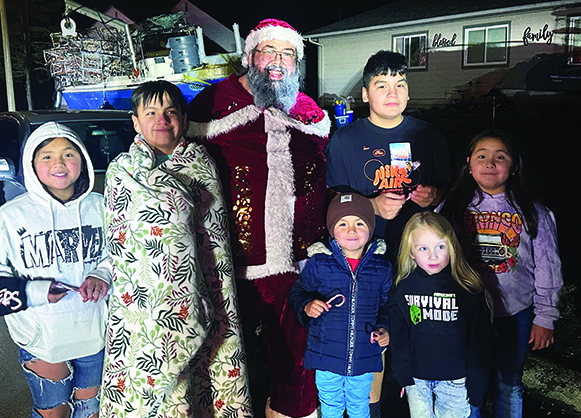
If you’d like to contribute or need assistance, the Tulalip Church of God Food Bank is open on the second and fourth Tuesday of each month from 10:30 a.m. to 4:00 p.m. It’s located at 1330 Marine Drive NE, Tulalip, WA, and can be reached at 360-653-7876.
December 14, 2024 syəcəb
Please use the following link to download the December 14, 2024 issue of the syəcəb
Wrapped in hope, love and caring: New blanketing ceremony honors work of beda?chelh families

By Kalvin Valdillez, Tulalip News
“I did receive a Pendleton and a blanketing ceremony! It was very emotional because they (beda?chelh team) all seen the growth, because I did grow a lot through the program. I was able to dig deeper into why I do what I do and why I think the way I do. And I’m really thankful that they acknowledge the work that is put in, that they acknowledge that you are a good parent. I feel that’s very important.”
-Jaida Wasko, Tulalip Parent/beda?chelh client
Shelly Lacy and her team at beda?chelh have been on a mission to reinstill trust with their clients since she took the helm at the Tribe’s child welfare program. This effort is to show the community that their number one goal is to keep Tribal families together and to reunite children with their parents, if the court removes them from the home.
A common misconception about the program is that beda?chelh’s only interest is separating the kids from their parents, and that beda?chelh makes the final decision to place them in another home. When in actuality, their role is to assess the child’s living environment and open a case if there’s a safety issue that calls for removal.
Following a co-investigation with the state, the Tribal court system will determine if the child needs to be placed in another home or can remain with the family. beda?chelh is there regardless of the outcome to help you plan your next step, whether that’s addressing those issues with the children still living in the home or beginning the reunification process.
Jaida Wasko, Tulalip Parent and beda?chelh client, recently regained custody of her kiddos. In an interview with Tulalip News, she expressed a great amount of gratitude for beda?chelh and her caseworker. And though her partner may have had a slightly different experience with beda?chelh, she credits the program for their growth as parents and states that with their help, they were able to reunite as a family in an expeditious fashion.
Said Jaida, “I feel like the program is protecting and looking out for the best interests of our children, whether or not people are able to see the hard work that they do. Because it is hard work pulling kids out of families when they don’t want to, but they have to. It’s case by case, but I feel it’s important for someone to step in and motivate parents to reunite and get better for the wellbeing of our kids. Because our kids need stability, discipline, structure. beda?chelh is a really good resource for people like me who are going through things, and they just can’t quite get out of it. They give me motivation to keep going.”
Through their latest efforts, like the implementation of a monthly cultural class for their families, beda?chelh is going the extra mile to show that they are a resource and not the enemy, that they care for the wellbeing of the kids and the entire family unit. And that they are there to support and uplift you through those challenging times.
“I had tested positive for fentanyl and meth, and my kids ended up having to come out of the home,” explained Jaida. “It was kind of hard because they were stuck between opening a case and not opening a case, because me and my husband were both functioning addicts. From the get-go, it was very hard, but they were very understanding. And at the end of the day, we are very thankful for the opportunities we did get. We were able to get help financially from them with clothing vouchers, food vouchers, gas vouchers. They were also able to get us into the same parenting classes, so we were able to do it together. It’s a lot of hard work, but if me and my husband can push through and do that work, anybody can.”

Upon the closure of a case, when the child is back in the care of their parents, Tribal Court usually holds a blanketing ceremony, accompanied by a prayer chant or song by local culture bearers. beda?chelh recently took this ceremony over, utilizing the event as an opportunity not only to acknowledge the families’ work of completing their journey with the program, but also to celebrate each accomplishment that their other clients make throughout their time with beda?chelh.
Shelly expressed, “That’s always the fun part of our job, because we get to celebrate that they’ve done it. We make sure to remind them of all their hard work, and how far they’ve come, because sometimes people think we don’t value their work. We want them to know how proud we are of the work they’ve done to get their kids back, reminding them that their kids will always remember the work that they’ve done for them. And then we’ll also award certificates at the celebration lunch, for every family that hits a major milestone.”
In Native America, a blanketing ceremony is held on momentous occasions, such as a graduation or a marriage, to honor your successes. The blanket serves as a physical reminder of your accomplishments and your growth through a certain phase of life, as well as an indicator that you are ready to begin your next journey. In traditional ceremonies or gatherings, blankets are a sign of wealth within tribal families, and to receive a blanket as a gift is a high honor.
When asked about the significance of the blanketing ceremony at beda?chelh, Shelly said, “Now, this is just how I think of it, because it depends on what family you’re in and where your beliefs come from. To me, when we wrap you in that blanket, we put our hopes for you, our love for you, our caring for you in that blanket. We are wrapping you in hope, love, and our caring, so when you’re having a rough day, you can wrap yourself up in that blanket and you can still feel that from us.”

With one last case on the verge of closure in the coming weeks, Jaida is excited to join the next blanketing ceremony and celebrate the work her family put in as well as the efforts made by other parents.
“It’s so awesome to see that they go out of their way to do blanket ceremonies for our people,” she said. “It was a surprise when it happened to me. I was surprised, it was emotional, and it shows that we truly do recover. My caseworker said she was so proud of us both, because they don’t see a lot of couples do it together. The way I look at it is our kids are our future. My kids are the most important people on the earth to me. And all the work that they do at beda?chelh is in the best interest of our kids, that’s who they are doing it for.”
Jaida and her family’s experience with beda?chelh is a good example of the saying ‘it works if you work it’. With many new success stories coming from beda?chelh, one could assess that team’s new hands-on approach and emphasis on celebrating their client’s victories is helping overturn that negative perception that many folks on the reservation hold against beda?chelh. One thing is for sure, the program is going to have to stock up on wool blankets as more parents are buying into the program, doing the work to reunite their families, and understanding the need for and the importance of the Tribe operating their own child welfare agency.
“It’s just about providing that extra layer of support for our clients. We really do want you to keep your kids, and we want to be there to help you get your kids back,” Shelly stated. “This is a way to really celebrate with the parents and give them that encouragement to keep going. Because it can feel like there is so much you have to do. It can seem like you have so far to go and you’re not going to make it. So, it’s important to stop and celebrate the work you’ve done.”
beda?chelh is planning to hold a blanket ceremony on the first Tuesday of every month to celebrate their clients’ accomplishments and inspire them to keep working toward reunification. The celebration will be held during the lunch hour at the beda?chelh headquarters. For more information, please contact Shelly Lacy at (360) 716-4059.
Holiday generosity shines bright at Festival of Trees
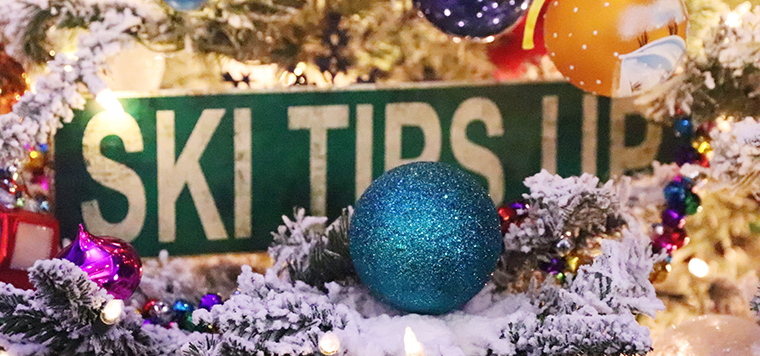
By Wade Sheldon, Tulalip News
On Friday, December 6, the Tulalip Tribes hosted the Providence General Foundation’s 39th Annual Festival of Trees Holiday Gala and Live Auction in the Orca Ballroom at the Tulalip Resort Casino. This cherished event brought together over 500 attendees, including community leaders, medical professionals, corporate executives, and other generous donors, to support a cause directly benefiting North Puget Sound’s children and families.
“This event has a long history; it’s the largest event of its kind in North Puget Sound.” shared Aimee Martin, Senior Philanthropy Officer with Providence General Foundation. “People come together during the holidays to make a difference in the lives of local children, ensuring they receive the care and support they need to thrive.”

One of the two chairpersons for the event, Tim Halliday, has been attending the Festival of Trees since the early 2000s. “He represents a second generation of giving back to the community and is passionate about supporting women’s and children’s services,” said Martin. Halliday, along with chairperson Karen Wetzel, ensured that the evening was an entertaining and smooth running success.
The gala featured 14 stunningly decorated Christmas trees designed by local community members. The auction of these trees raised thousands of dollars, with seven trees donated back to local organizations, including the Tulalip Boys and Girls Club. Interestingly, the trees already slated for donation drew the most considerable bids of the evening.
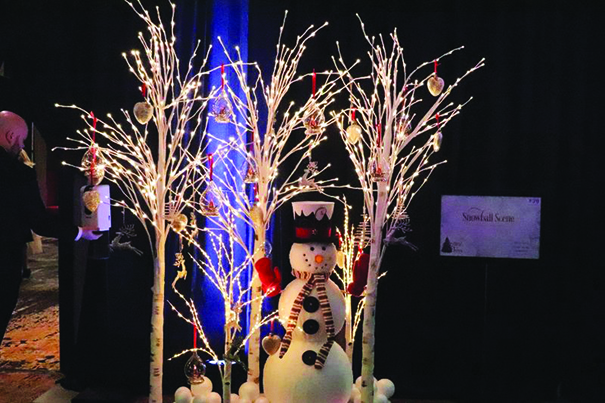
The highest bid went to the Decadent Holiday Dreams tree, which sold for an astounding $33,000. The winning bidder agreed to donate the tree and its gifts to Dawson Place, a center dedicated to helping children in need. The tree was a whimsical masterpiece adorned with pastel sweets, sugary donuts, cotton candy garland, and ornaments shaped like macarons, cakes, candies, and sprinkled donuts. It also included plush Squishmallow toys, 77 free drink gift cards, and other delightful surprises, making it a true treasure trove of holiday cheer.
This year’s gala proceeds will benefit children’s services at Providence Regional Medical Center in Everett. Martin explained, “The children’s services fund offers comprehensive support to children under Providence’s care. Contributions will help finance vital programs and services, including our Neonatal Intensive Care Unit, The Children’s Center, the Providence Boyden Family Autism Center, and Camp Prov, a summer camp for kids with special health care needs.”

A unique “Fund-a-Need” portion of the evening raised additional funds for the Providence Pavilion for Women and Children, supporting safe and healthy births for mothers and babies.
“It’s a higher priority at Providence to guarantee that babies and children receive the necessary care and support to grow strong,” Martin emphasized.
A highlight of the evening was the presentation of the Spirit of Festival Award to local florist Stadium Flowers. “Since the late 1980s, Stadium Flowers has been a cornerstone of the Festival of Trees,” said Martin. “Their stunning floral arrangements enhance the ambiance yearly, and we’re excited to recognize their contributions.”
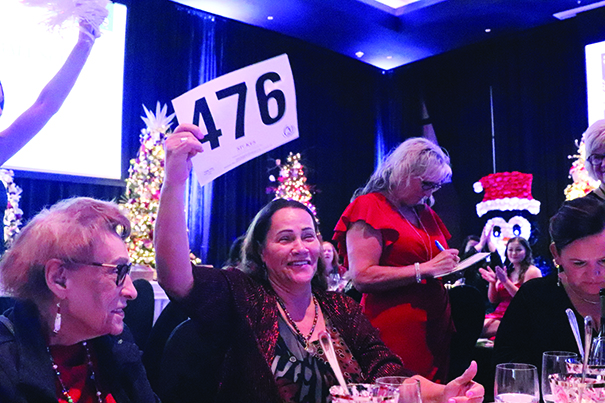
Reflecting on the generosity of the event, Tulalip Tribal Chairwoman Teri Gobin shared, “It’s wonderful that we could donate that money, see these beautiful lights, and it’s for a good cause, especially to help with the kids at the Providence hospital.”
The Tulalip Tribes bid on two displays during the auction, one of which will be at the Tulalip Tribes Administration Building, further sharing the holiday cheer with their community.
The Annual Festival of Trees Holiday Gala demonstrated the power of community, generosity, and holiday spirit. From the beautifully designed trees to the heartfelt donations, an incredible $1,452,581 was raised to benefit children’s services in the region.
“This event is an opportunity for people to give back during a special time of year,” Martin said. “It’s a generous group of people coming together to make a meaningful difference in the healthcare of North Puget Sound.”
For nearly four decades, the Festival of Trees has been a beacon of hope and support for children and families, and this year’s event spectacularly continued that tradition.
Lady Hawks start off season 1-0

By Micheal Rios, Tulalip News
The Tulalip Heritage girls basketball team returned to the court for the 2024-2025 season on December 5 in an away game vs. the Shoreline Chargers. Many of the core players from last season are back, plus some key additions to give the Lady Hawks more depth and more skill sets for head coach Sabrina Moses to work with.
“We’ve added several new players, including Aylani Lewis. She’s just a freshman, but has the game of a much older player. She’s a true point guard who can control the tempo of our offense and get us into sets that her teammates are comfortable with,” said coach Sabrina. “She’s joining her sister Raylee who played with us last year.
“Also returning are sisters Lilly and Isabelle Jefferson to fortify our defense. I can always count on them to give full effort every minute they are on the court, which gives us an intensity we need.”
Controlled tempo on offense and intense defense were both on display by the Lady Hawks in their dismantling of Shoreline. Aylani’s effectiveness with the ball in her hands was evident from the jump. She scored 12 points in the 1st quarter by blowing by much larger defenders and scoring layups over their outstretched arms. Meanwhile, Heritage’s defense was wreaking havoc. The girls were jumping passing lanes and hounding Chargers ballhandlers into one turnover after another.

After one quarter of play, Tulalip led 16-2. They stretched that lead to 22-5 at halftime. In the 3rd quarter, Lady Hawks forward Laniyah Moore made the most of a couple well-timed offense rebounds and scored on back-to-back high percentage shots.
The Lady Hawks were rolling until an unfortunate moment of friendly fire when Aylani and fellow guard Audrielle Mclean both went for a loose ball and collided at full speed. The collision resulted in both players exiting the game; Audrielle with a forehead cut that required 5 stitches and Aylani with concussion-like symptoms.
Without their top playmakers, the Lady Hawks held on for a well-deserved 34-18 victory. Aylani led all scorers with 15 points, while Laniyah and big sister Raylee both added 6 points each.
Following the season opening win, Lilly shared, “It felt really good to get this win. For me personally, I worked a lot on my shooting and dribbling to be more confident in games. Last year, I looked to pass lot. Now, I’m looking to shoot and handle the ball more, when the team needs it. It paid off tonight after losing Audrielle and Aylani, I was asked to play point guard. It helped for me to get to the areas I like to shoot, and I made a couple buckets in that 4th quarter. It just feels good to be undefeated
———————————————-
Without several starters, Lady Hawks fall to Darrington
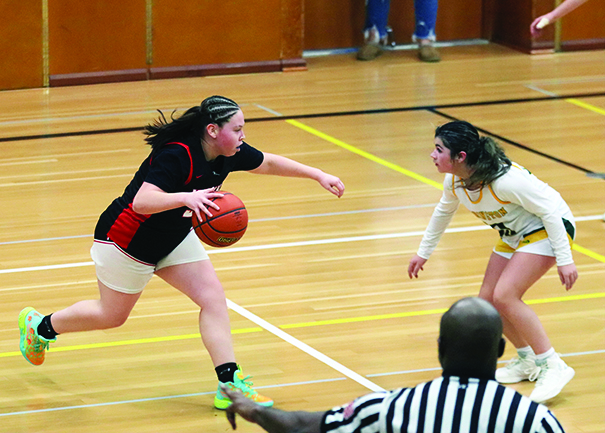
The Lady Hawks produced a valiant effort on the evening of December 9. In their second straight road game to the start the season, the Heritage girls played the Darrington Loggers extremely shorthanded. In fact, they were down three starters; both Lewis sisters and Audrielle Mclean.
Without their primary ballhandlers, sisters Lilly and Isabelle Jefferson were asked to step up and run the offense. Playing against a Logger’s defense consistently applying full court pressure, the sisters were regularly forced to dribble around multiple Darrington defenders just to get the ball up court. The constant pressure made it difficult for the Lady Hawks to execute their sets, let alone produce an unhindered view of the basket to attempt a shot.
Undermanned and outgunned, the Lady Hawks trailed 5-28 at halftime, and ended up losing 13-47. Isabelle led the Lady Hawks with 4 points.

Even in an emphatic loss there are always positives. With the injuries, several players got extended run. One such player was freshman Janiesha Zackuse. She scored her first Lady Hawk point with a made free throw. Something she knew made her family who made the hour-long venture to watch her very happy.
“It felt pretty good to play so much. I’m tired out now though,” admitted Janiesha post-game. “We had a lot of supporters in the stands. It’s pretty awesome to see everybody who drove all this way to watch us play.”
Hawks begin 24-25 season with emphatic win
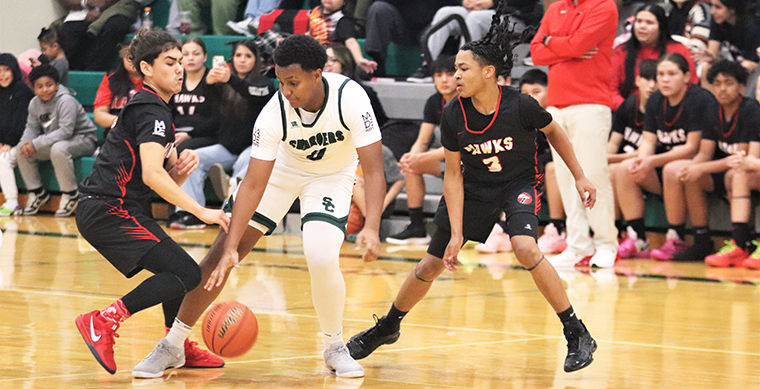
By Micheal Rios, Tulalip News
Last season, the Heritage Hawks basketball program exceeded even the loftiest of expectations. They began the season (1-3) while developing their on-court identity with a mix of stout senior players and phenomenally talented freshman. Once they found their rhythm and groove, they also discovered their winning ways. Their midseason turnaround culminated in a 2nd place finish at Districts, 3rd place finish at Tri-Districts and, ultimately, the boys fell just one win short from a State Tournament bid.
The Hawks are returning a number of players from that (17-9) squad, including the starting backcourt of J.J. Gray and Amare Hatch who are both sophomores now. They are joined by a plethora of new faces who are eager to carve out impactful roles on a team primed to build off last season’s success.
“We’re looking to accomplish all around growth for the program, and to continue developing our boys for what we hope is another lengthy post season run. Of course, this year we want to make it all the way to State,” shared Heritage head coach Shawn Sanchey. “It’s been so exciting being able to watch our program grow and to receive so much support from our community. When we’re winning in front of packed crowds, it really doesn’t get much better than that.”
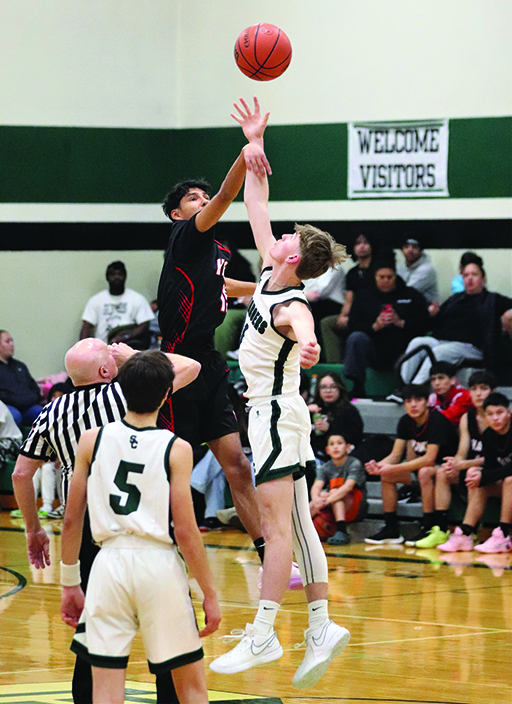
The 24-25 season officially kicked off on Thursday, December 5, when Tulalip travelled to Shoreline High School for an away game against the Chargers. It was less a game and more a coming out party for the new-look Hawks.
The J.J. and Amare pairing as playing making combo guards who can just as easily stroke a 3-pointer as they can beat their man off the dribble and finesse in a layup, scored 19 points in the early going to give their team a commanding 34-5 lead. This pleased the many Heritage fans who journeyed south to swarm the Shoreline gymnasium.
In the 3rd quarter, newcomer Ziggy Myles-Gilford did his best Dennis Rodman impersonation by gobbling up every loose rebound and scoring off high percentage shots in the painted area. The Tulalip forward accounted for 14 points and nearly as many rebounds in that third frame. With the game all but a wrap, Coach Sanchey unleashed his bench players to have their fun during the 4th quarter.
After the decisive 75-19 season opening victory, guard Amare said, “Our on-ball defense was on point tonight. I don’t know how many steals we ended up with, but it was a lot, that’s for sure. I think our team chemistry is already at a good place because so many of us have been playing together in Native tournaments. All those extra games and reps have gotten us comfortable with each other’s games. We want to be better than we were last year and this first W is just the start.”
In total, ten Heritage boys registered a bucket in the blowout win. Ziggy led all scorers with 20 points.
————————————————–
Hawks chop down Loggers, 90-46

With more Tulalip fans in attendance than Logger fans, the energy was more befitting a home game for the Heritage boys playing in Darrington. Chants of “Tulalip power!” rang out early and often as the Hawks break neck pace led to a 26-13 first quarter lead.
The long ball wasn’t falling, or any jumper for that matter, but it didn’t matter because the Hawks couldn’t be denied from getting to the basket whenever they wanted. Both Hawks forwards, Ziggy Myles-Gilford and Tokala Black Tomahawk, controlled the glass and routinely corralled offensive rebounds to give their team additional offensive possessions. The two Hawks bigs combined to score 25 points in the 1st half and were a big reason why Tulalip led 47-26 at halftime.
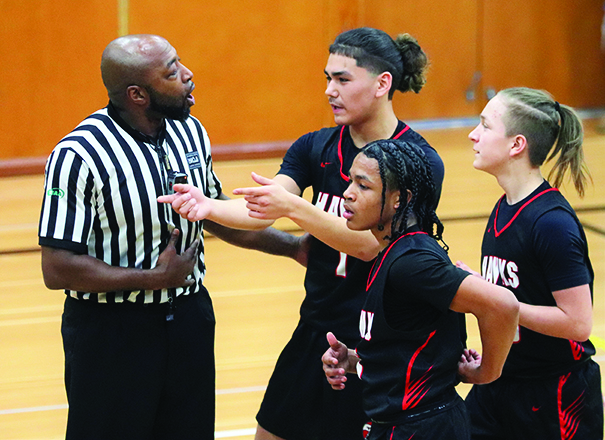
In the 3rd quarter, the 3 ball finally started to go in for the Hawks shooters. Amare Hatch, J.J. Gray, and Deveyon Wells each made a 3-pointer to help extend their team’s lead. Up big, 77-35, to begin the 4th quarter coach Shawn inserted his bench players to get in on the scoring frenzy.
Stunned Logger fans even got to witness a couple Ziggy dunks, tomahawk style. His dunks were just the cherry on top of his career night 30 points and 20-something rebounds enroute to Tulalip securing a 90-46 win.
The unbeaten (2-0) Hawks received additional scoring from Amare who chipped in 15 points, while J.J. and Tokala each added 13 points.